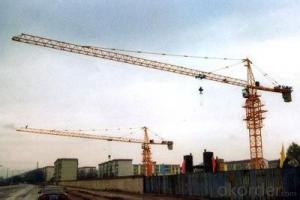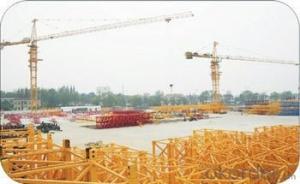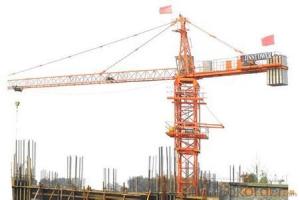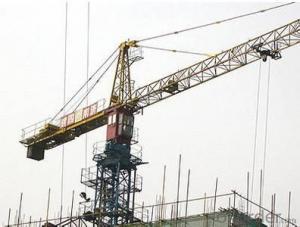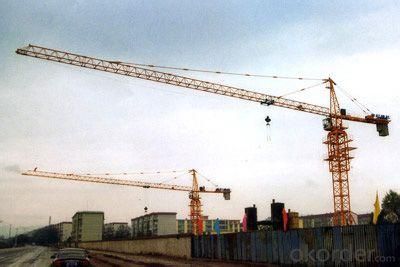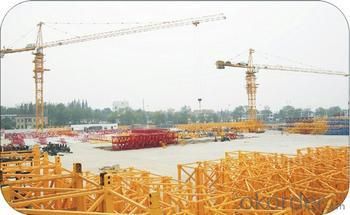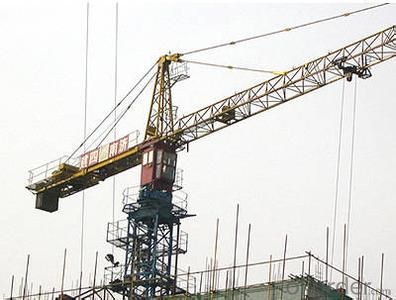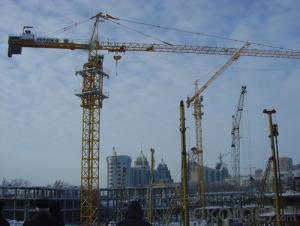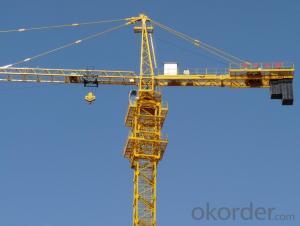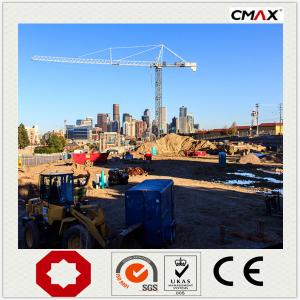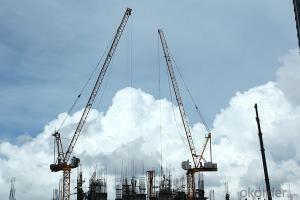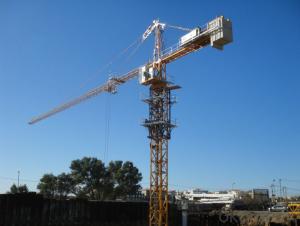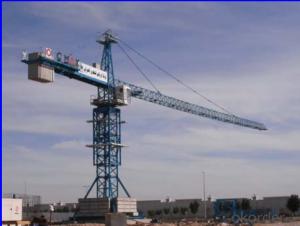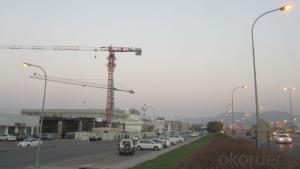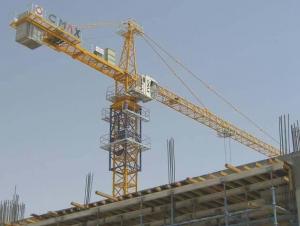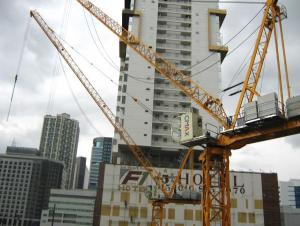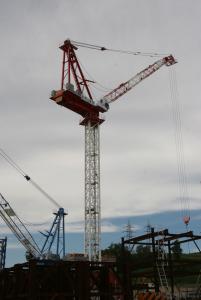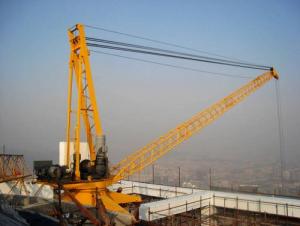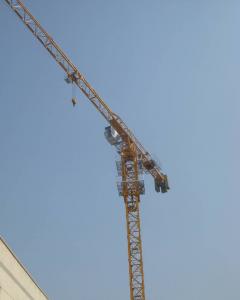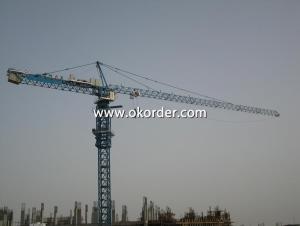QTZ50(4810) tower crane
- Loading Port:
- Qingdao
- Payment Terms:
- TT OR LC
- Min Order Qty:
- 1 set
- Supply Capability:
- 12 set/month
OKorder Service Pledge
OKorder Financial Service
You Might Also Like
QTZ50(4810) tower crane is hoisting and conveying machinery which is designed by Shandong Fuyou Co., Ltd. by fully utilizing the group technology, the combinational design technology and the finite element analysis technology and taking the tower crane microcomputer design platform as a tool and has excellent performance.
The crane is a horizontal-arm-rest trolley-amplitude upper-revolution hydraulic lifting type crane which has the effective amplitude of 48m and the maximum lifting moment of 544kN•m. The tower crane has the lifting height of 30m and the adhesion lifting height of 120m (2 magnification) during independent use.
All the speed indexes of the crane meet or surpass national standards.
The crane has the total installed capacity of 24.9kW, features advanced parameters, excellent and reliable properties, attractive appearance, high quality, simple and practical structures, advanced safety devices, convenient maintenance, safe usage and reasonable prices, and is ideal construction machinery for many medium-small construction enterprises.
2. Lifting Technical Performance
2.1 Lifting Performance Table and Lifting Performance Curve
(1) 4-magnification Lifting Performance Table
The lifting boom and balance boom adopt cantilever boom structure, which reduces the hoisting modular and makes it more safe, convenient and flexible to install and uninstall, and reduces the requirements for hoisting equipment and the site.
2. Multiple special mounting brackets are available, which saves the installation time and ensures safe and quality installation.
3. The lifting boom adopts cantilever boom structure and variable cross-section materials, featuring more reasonable structural stress and long service life; and it is easier to make different combination of boom length.
| Amplitude(m) | 3-13.6 | 14 | 15 | 16 | 17 | 18 | 19 | 20 | 21 | 22 | 23 |
Lifting capacity(kg) | 4000 | 3890 | 3618 | 3380 | 3170 | 2860 | 2810 | 2660 | 2530 | 2400 | 2290 |
Amplitude(m) | 24 | 25 | 26 | 27 | 28 | 29 | 30 | 31 | 32 | 33 | 34 |
Lifting capacity(kg) | 2190 | 2090 | 2000 | 1920 | 1850 | 1770 | 1710 | 1650 | 1590 | 1540 | 1490 |
Amplitude(m) | 35 | 36 | 37 | 38 | 39 | 40 | 41 | 42 | 43 | 44 | 45 |
Lifting capacity(kg) | 1440 | 1390 | 1350 | 1310 | 1270 | 1230 | 1200 | 1170 | 1130 | 1100 | 1070 |
Amplitude(m) | 46 | 47 | 48 | ||||||||
Lifting capacity(kg) | 1050 | 1020 | 1000 |
(2)2-magnification Lifting Performance Table
Amplitude(m) | 3-26 | 27 | 28 | 29 | 30 | 31 | 32 | 33 | 34 | 35 |
Lifting capacity(kg) | 2000 | 1920 | 1850 | 1770 | 1710 | 1650 | 1590 | 1540 | 1490 | 1440 |
Amplitude(m) | 36 | 37 | 38 | 39 | 40 | 41 | 42 | 43 | 44 | 45 |
Lifting capacity(kg) | 1390 | 1350 | 1310 | 1270 | 1230 | 1200 | 1170 | 1130 | 1100 | 1070 |
Amplitude(m) | 46 | 47 | 48 | |||||||
Lifting capacity(kg) | 1050 | 1020 | 1000 |
Technical Performance Parameter Table
Item | Unit | Magnification | ||
α=2 | α=4 | |||
Rated lifting moment | kN.m | 500 | ||
Maximum lifting capacity | t | 2 | 4 | |
Working amplitude | m | 3 ~48 | ||
Maximum amplitude lifting capacity | t | 1.0 | ||
Lifting height | Independent | m | 30 | |
Attached | m | 120 | ||
Time of moving outrigger end to rotation center | m | 48.74 | ||
Time of moving balance arm tail to rotation center | m | 12.816 | ||
Counter weight | t | 7 | ||
Total motor power | kW | 24.9 | ||
Allowable working temperature | 0C | -20~+40 | ||
- Q: I've always wondered, how do they lift cranes? Bigger cranes? What do you think/know?
- The use other large cranes. They put them up there piece by piece, and sometimes use cranes on the ground to hold pieces up while they assemble them.
- Q: Under what circumstances does a tower crane require third party testing?
- New clothes, relocation or transformation should be examined by the quality and Technical Supervision Bureau
- Q: How do tower cranes rise?
- A tower crane raises weights by clicking on the reverse;Tower crane (tower crane) is called tower crane, also known as tower crane, originated in Western europe. A revolving crane mounted on top of a tall tower. The working space is large, mainly used for the vertical and horizontal transportation of materials and the installation of building components during the building construction. It consists of three parts: metal structure, working mechanism and electrical system. The metal structure includes the tower, the boom and the base. The working mechanism has four parts, lifting, luffing, turning and walking. The electrical system consists of motors, controllers, power distribution cabinets, connecting lines, signals and lighting devices, etc..
- Q: I have this assignment to find out how a climbing crane is able to move up the building as construction continues.
- They add extra stages from the bottom. A tower crane is erected from a boom assembly, first and second tower sections of different cross section, and a base in a sequence of steps in which the boom assembly is mounted on a hollow climbing section dimensioned to be received in each of the larger second tower sections and defining a cavity dimensioned to receive each of the first tower sections. One of the latter is secured on a base in upright position, and the upright section is received in the cavity of the climbing section which is then raised relative to the first section and enveloped by one of the second sections. The enveloping section is secured to the base and the raised climbing section for supporting the climbing section whereupon the first tower section may be released from the base, raised, and secured to the second tower section. The climbing section may then be raised relative to the first tower section to permit the installation of another second section, and the procedure repeated, until all second or larger tower sections are superimposed on each other, the one first section being ultimately attached to the topmost second section. When the climbing section is raised relative to the attached first section, another first section may be superimposed on the one first section and the procedure repeated until the slimmer portion of the tower is assembled from superimposed first sections. Ultimately, the boom assembly is attached to the topmost first tower section, and the climbing section may be removed or stored for further use on the wider, lower tower portion.
- Q: Formulas for calculating outrigger pad sizes, centre of gravity of loads, outrigger loadings
- If you are going to be operating a crane, you need to do this on your own. People's lives will depend on you having a good knowledge in this area. .
- Q: What are the main technical parameters of a tower crane?
- Generally speaking, the main parameters of the tower crane are:Maximum amplitude unit MMaximum lifting height, unit MMaximum lifting torque unit KN.mMaximum lifting speed unit m/minMaximum lifting unit tRotational speed unit r/minVariable speed unit m/min or o/minWalking speed per unit m/minMotor power unit w......Please refer to the product manual.
- Q: How many meters does the tower crane installation height require expert proof?
- The mounting height of the tower crane is determined by the manufacturer's manual,It has nothing to do with experts,After the tower crane is installed, it needs to go through the provincial construction quality and safety supervision station, and the designated testing institution will meet the technical requirements of the production plant, and the method can be used only after the use of the permit.
- Q: What kind of force acting in the brake system which encounter the lifting material force and to maintain its level.
- Cranes work using hydraulics and cables. The cables are wrapped around pulleys and the pulley is turned using hydraulic power. The brake system is simply stopping the pulley from turning by reducing power. The hydraulic system typically will turn a series of gears which in turn spins the pulley that the cable is wrapped around. It's different than a brake system say on a car where when you hit the brakes, pads squeeze on the interior of the wheel rim slowing it down. Cranes you just reduce power and stop the pulley from turning. They also have emergency stops. Older cranes have wedges that would be released onto the cable and then the wedges would grab the cable and slip into a ring. The narrow end of the wedges would slip into the ring first and then as the wedges increased in diameter the grip on the cable would get tighter and then stop the cable from moving. They also have systems on the pulleys to stop the pulley from spinning. They essentially work the same way as a car break. When the emergency brake is triggered, pads will squeeze on the rim of the pulley to stop it. These mechanisms work by friction. They could also have holes around the pulley and a steel pin would be pushed into one of the holes to stop it from spinning. Of course if the force of the weight exceeded the strength of the pin, it would shear.
- Q: The earthing resistance of tower crane shall not be greater than that of the tower crane
- Three. Technical specification for temporary power safety on construction site JGJ 46-20055.4.2 within the construction site crane, derrick and Longmen machinery equipment, metal structure and steel scaffolding and under construction in construction projects, when lightning protection devices in adjacent buildings, structures and other facilities outside the protect zone of lightning arrester, lightning protection device should be installed in accordance with the provisions of.5.4.7 lightning protection electrical equipment machinery, connected to the PE line must repeat grounding at the same time, with a repeat of the mechanical and electrical equipment grounding and lightning protection grounding machines can share the same grounding body, but should be consistent with the repeated grounding resistance of grounding resistance requirements.The electrical equipment of 9.2.1 tower crane shall comply with the requirements of the current national standard "safety regulations for tower cranes" GB5144.9.2.2 tower cranes shall be subjected to repeated earthing and lightning protection grounding as specified in Clause 5.4.7 of this code. The earthing device of the track type tower crane shall comply with the following requirements:L the two ends of the rail are respectively provided with a grounding device;The joint of the 2 track is electrically connected, and the ends of the two tracks are electrically connected in the loop;3 long track every is not more than 30m and a grounding device.
- Q: any kind of sayings
- You could just say whooping crane in another language, like Grue blanche (French) or Grulla blanca (Spanish). .
Send your message to us
QTZ50(4810) tower crane
- Loading Port:
- Qingdao
- Payment Terms:
- TT OR LC
- Min Order Qty:
- 1 set
- Supply Capability:
- 12 set/month
OKorder Service Pledge
OKorder Financial Service
Similar products
Hot products
Hot Searches
Related keywords
